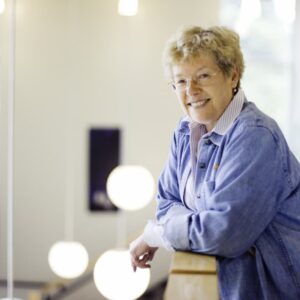Vast Views, Close to Home
Share

Sandra Faber WF ’66 H has been studying the formation of galaxies for more than 40 years. She has played key roles in the discovery of dark matter in the universe and supermassive black holes in the nuclei of galaxies. Widely considered one of the world’s leading authorities on telescopes, she diagnosed the flaw in the Hubble Space Telescope’s mirror in the early 1990s. In 2013 she received the National Medal of Science.
Now, this is all bringing Dr. Faber right back to Earth.
University Professor Emerita of Astronomy and Astrophysics at the University of California, Santa Cruz, and Interim Director of the University of California Observatories from 2012 to 2014, Dr. Faber has been focusing recently on the perspective that cosmology brings to intelligent life on this planet.
Through astronomical observation and the laws of physics, she notes, “We can understand where we came from and we can understand our fate. We can see how Earth got here, and we can see that we still have hundreds of millions of years of good living here on this Earth; what are we going to do with it? What is our destiny here? Astronomy is creating the stage on which these questions can be discussed for the first time in human history.”
In the early 1980s, Dr. Faber and her colleagues Joel Primack (also WF ‘66 H) and George Blumenthal (now UCSC Chancellor) articulated a theory of galaxy formation, based on “cold dark matter”, that has since been borne out by observations and simulations. The theory, she is quick to point out, “doesn’t explain the origin of our Universe”—it takes the Big Bang as a given—“but it does explain the Universe of galaxies that see today.”
In an infinitesimal fraction of a second after the Big Bang, Dr. Faber explains, quantum mechanics produced slight fluctuations in the density of the Universe’s energy. “These density fluctuations in turn,” she explains, “created larger peaks of energy density, generating more gravity, slowing the expansion of the Universe, and drawing matter in. These microscopic peaks grew to become the giant galaxies of today.”
While other observers had proposed similar models, Dr. Faber’s team accurately calculated the quantity and quality of the galaxies that would be generated by such a process. “I’ve had the pleasure,” she says,” of watching the scientific community elucidate and try to prove a theory that I helped to generate as a young person.”
Dr. Faber’s subsequent work—including the Faber-Jackson relation, a scaling law of galaxies; her studies with the Nuker Team on supermassive black holes at the hearts of galaxies; and, most recently, CANDELS, a survey of the early Universe and the largest project in the Hubble Telescope’s history—has continued to pioneer new understandings of the structure of the Universe. To date, her career has encompassed more than 350 scientific publications with over 50,000 citations.
Retirement notwithstanding, Dr. Faber remains closely involved in new astronomical developments, including more sophisticated observation of exoplanets and planetary formation, which the James Webb Space Telescope will make possible. She is particularly enthusiastic about the next generation of ground-based telescopes, which, through adaptive optics, will counter the distortion created by Earth’s atmosphere. “These telescopes will be ten times sharper than Hubble,” she says, “and have the capability of capturing light 100 times fainter—from the ground. Every time in astronomy we’ve opened up a new part of parameter space by that amount we’ve found very interesting things.”
When she applied for the Woodrow Wilson Fellowship in fall 1965, then-student Sandy Moore wrote of being inspired, as a young observer, by “the overwhelming presence of the Universe.” The Swarthmore senior added, “Through its ability to transcend our tiny sphere of human thought and action, [astronomy] to me imbues each small fact about the Universe with tremendous importance.”
Today, as she told a TEDx audience in 2011, “After 40 years in this field, the cosmologist on the left brain is meeting the citizen on the right brain, and they are trying to inhabit the same body, and struggling.” The scale of cosmology, she observes, makes it clear that runaway use of Earth’s resources cannot be remedied by a quick move to another nearby home or by help from other intelligent beings. “Astronomy tells us that help, if there is help, is very far away. No one is coming to save us. We are hanging in a void and it’s only 10 miles away, through a thin atmosphere that’s easy to destroy.” As the first generation with scientific evidence to show just how true this is, Dr. Faber argues, we must think urgently about how to protect the planet.
The most important lesson from all this for the average layperson, she says: “This makes Earth rare and precious. And if Earth is rare and precious, then so are we.”
Dr. Faber was awarded the 2017 Gruber Cosmology Prize for her work which “established many of the foundational principles underlying the modern understanding of the universe on the largest scales.” The Cosmology Prize, awarded by the Gruber Foundation, acknowledges and encourages further exploration in a field that shapes the way we perceive and comprehend our universe.
This story appeared in the spring 2017 issue of Fellowship, the newsletter of the Woodrow Wilson Foundation.
Stay Engaged
Get More News
Join our mailing list to get more news like this to your mailbox.
Support Our Work
Help us invest in the talent, ideas, and networks that will develop young people as effective, lifelong citizens.
Ways to Support Us